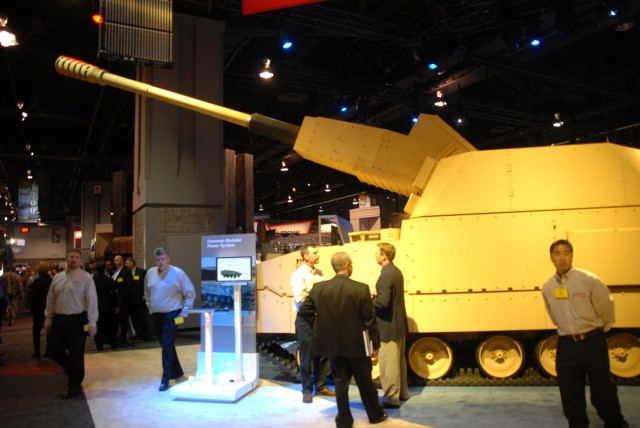
WASHINGTON (Army News Service, Oct. 8, 2008) -- New Army fighting vehicles promise to transform the nature of war as dramatically as the tank did in the 20th Century, said Army Vice Chief of Staff Gen. Peter W. Chiarelli in remarks delivered Monday at an annual breakfast meeting of the Association of the United States Army.
The Army, however, needs to better explain the revolutionary potential of these vehicles, Chiarelli said, while acting to hasten their delivery and fielding.
The FCS Manned Ground Vehicle "is a platform designed for the full-spectrum fight," Chiarelli said. "The self-sufficient nature of the system has a vast array of networked capabilities that will literally change the game in favor of the Soldier."
The Army, though, has had great difficulty explaining this revolutionary potential to policymakers and the public. "We can all intuitively see the benefits of rolling this technology into the force," Chiarelli said. Yet there are phenomenal misperceptions about the program."
One misperception, according to the general, is that the FCS vehicles are simply new tanks. But since the Army already has the most powerful and effective tanks in the world, people are skeptical that the Army requires new FCS vehicles.
Chiarelli harkened back to history to explain that not all tanks are equal; and he looked to the future to explain that something more than tanks are required if U.S. Soldiers are to "dominate, not survive, in a full-spectrum operating environment."
Full-Spectrum Operations
Emerging global trends --including rapid population growth, the rise of extremism, and advances in information technologies -- are all conspiring, Chiarelli said, to create an era of persistent conflict. This era of persistent conflict will require that soldiers engage in "full-spectrum operations."
The general cited Secretary of Defense Robert Gates, who in a speech last week at National Defense University said: "The categories of warfare are blurring and do not fit into neat, tidy boxes."
Full-spectrum operations, Chiarelli said, involve the entire spectrum of tactical challenges, both kinetic and non-kinetic activity. There are "elements of both, all the time, shifting constantly, sometimes without warning."
But current-force Army vehicles were designed for the Cold War and heavy conventional conflict; they were not designed for full-spectrum operations and asymmetric warfare.
More recent Army tank variants, such as the M-1A2 Abrams have more modern systems enhancements, which make them better suited to 21st Century asymmetric conflicts. That's why Chiarelli said, when he was commanding Multi-National Corps-Iraq, he specifically asked for the M-1A2 variant. The Army, however, wanted to give him the old M-1A1 Abrams. "Pete, a tank is just a tank," he was told.
But "if you know anything about fighting a tank in urban terrain and the capability the independent sights give you," the general said, "you realize the error of 'a tank is a tank.' A tank is not a tank."
The independent sights on the M-1A2 give soldiers much greater standoff observation capability and protection. This standoff observation capability and protection "dominated the fight [in Iraq] and kept our troopers safe," Chiarelli said.
The FCS MGVs, he added, will accelerate this trend because they are specifically designed to empower and protect soldiers for full-spectrum operations. Army officials say that weight, space and power constraints on the Abrams Tank, Bradley Fighting Vehicle and Stryker Interim Armored Vehicle seriously limit their ability to modernize these and other current-force platforms.
History Lesson
Even within the Army, not everyone understands the revolutionary importance of the FCS MGVs. But nearly a century ago, not everyone understood the revolutionary importance of the tank either.
Chiarelli said that after World War I, two young Army officers named Dwight D. Eisenhower and George S. Patton, saw how "the tank, coupled with other emerging technologies, could literally revolutionize warfare. Yet institutional bias kicked in. A well-placed call from a senior officer (in this case the Chief of Infantry), literally killed the birth of modern warfare for almost 10 years."
The General quoted historian Stephen Ambrose who wrote: "Patton and Eisenhower were true pioneers, original and creative in their thought. But the Army was not pleased."
"We cannot afford a 10-year delay of an idea," Chiarelli said. "We have to keep pushing the realm of the possible into the edge of the impossible, and then quickly -- quickly -- spin off what we can into the hands of our Soldiers."
The General again quoted Secretary Gates: "Our conventional modernization programs seek a 99% solution in years," Secretary Gates said at National Defense University. "The wars we are in require 75% solutions in months. The challenge is whether in our bureaucracy and in our minds these two different paradigms can be made to coexist."
Chiarelli urged the Army to accelerate FCS modernization and to learn from soldiers in the field. "Only once we put it [FCS] in the hands of those young troopers fighting and learning will we truly, truly know what we have created," he said.
An Army Evaluation Task Force has been stood up at Fort Bliss, Texas, to test, evaluate and refine new FCS gear and equipment. The AETF is comprised of more than 1,000 soldiers, most of them recent combat veterans from Iraq and Afghanistan.
"If FCS accomplishes 70 percent of what we are asking of it, it becomes an engine of creativity for decentralized solutions," Chiarelli said.

Social Sharing